INTRODUCTION
Batman v Superman: Dawn of Justice is the first Batman movie to extensively incorporate elements from the wider DC universe, as well as the first live-action feature film to unite Batman, Superman, and Wonder Woman on the big screen. While the movie has met a divisive response from fans, it's undeniable that director Zack Snyder looked to the source material for much of his inspiration.
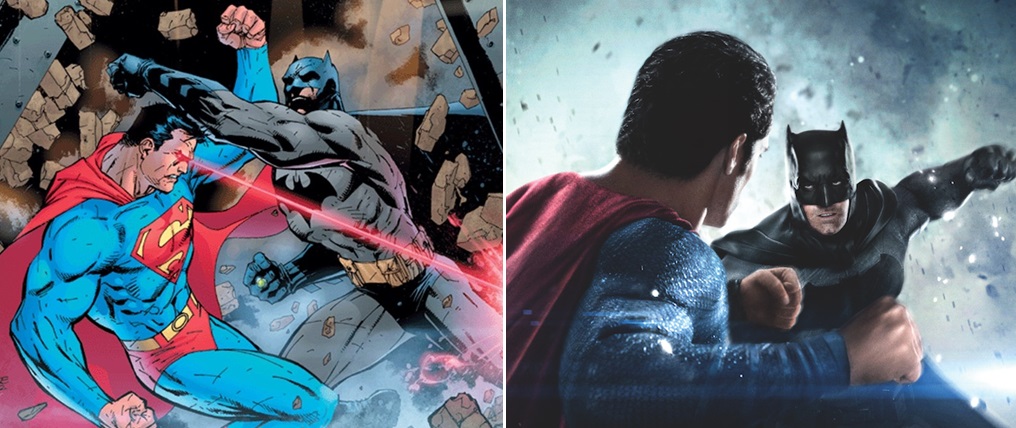
The single biggest comic book influence is undoubtedly Frank Miller’s The Dark Knight Returns (1986), a book which has been cited numerous times by the cast and crew as having shaped the film’s overall conception:
"The comic book [The Dark Knight Returns] will influence the history of Batman vs. Superman, on which the writer David S. Goyer and myself will work."
Zack Snyder, quote during an interview with French magazine Popcorn in 2013.
In addition to Miller’s work, the film also draws influences from the Superman and Justice League comics, as well as Jack Kirby’s Fourth World. We’re going to try and list as many of these influences here as we can find.
The film begins with a montage recapping Batman’s origin story. We see the Waynes – Thomas (Jeffrey Dean Morgan), Martha (Lauren Cohan), and the young Bruce (Brandon Spink) – leaving a theatre where Tyrone Power's The Mark of Zorro (1940) is playing. This was the film they went to see in The Dark Knight Returns. Another visual detail taken from that story is Thomas having a moustache, as opposed to earlier depictions where he was clean-shaven.
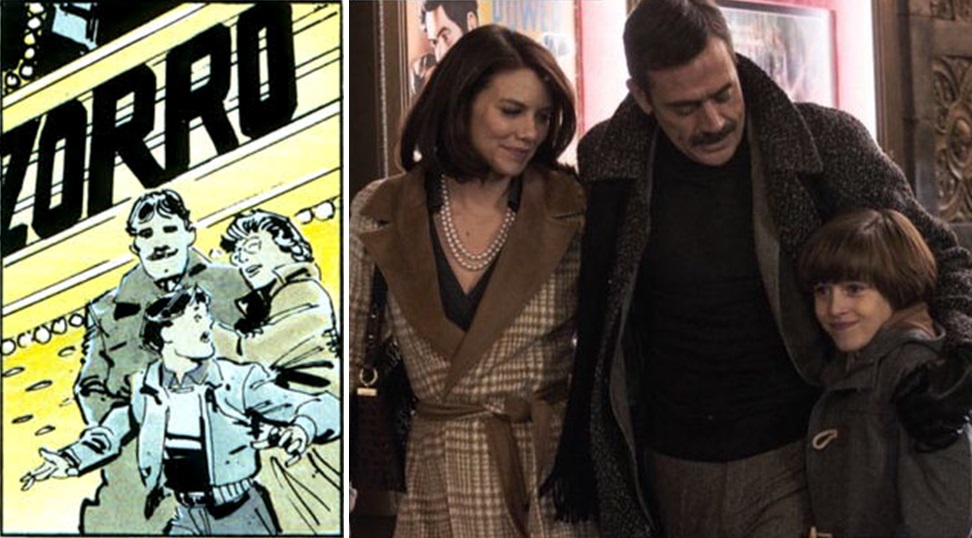
They are confronted outside the theatre by a mugger wielding a gun.
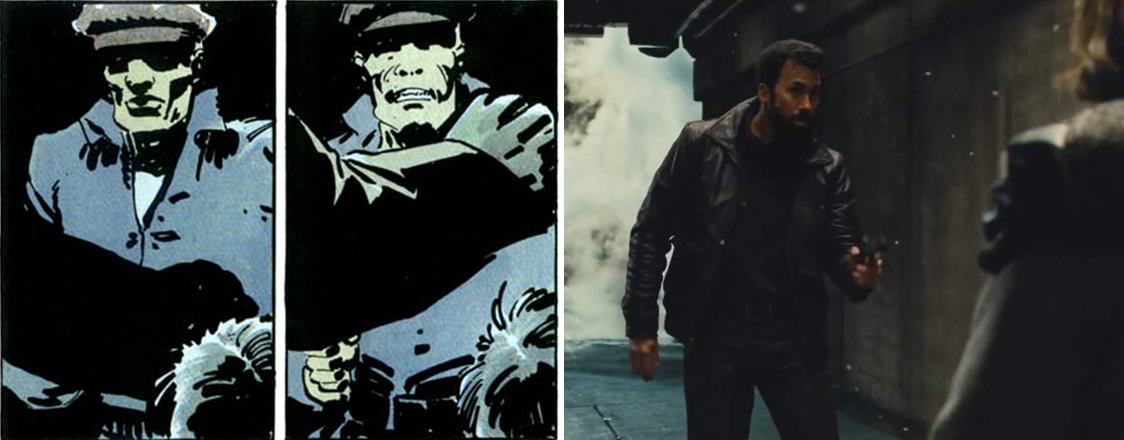
Thomas attempts to defend his family by striking the mugger. The close-up of his hand forming a fist is another image taken from The Dark Knight Returns.
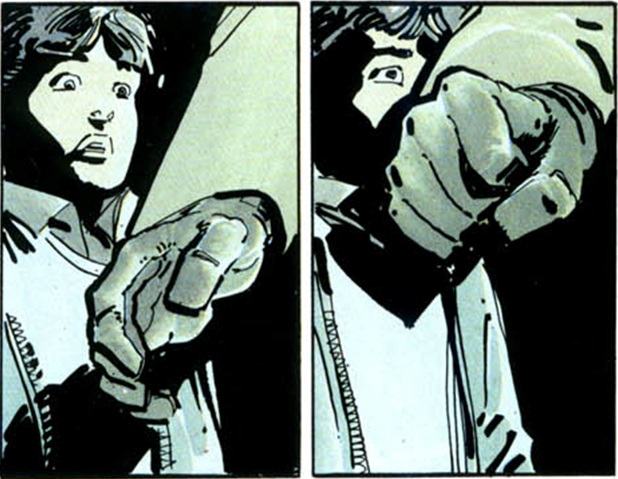
Thomas also lunged at the mugger to defend his family in the very first depiction of Batman’s origin, way back in ‘The Batman Wars Against the Dirigible of Doom’ (Detective Comics Vol 1 #33, November 1939).
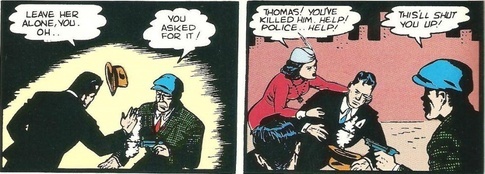
After shooting Thomas, the mugger gets his gun tangled in Martha’s pearl necklace. The necklace breaks when he shoots her, and the pearls fall to the ground.
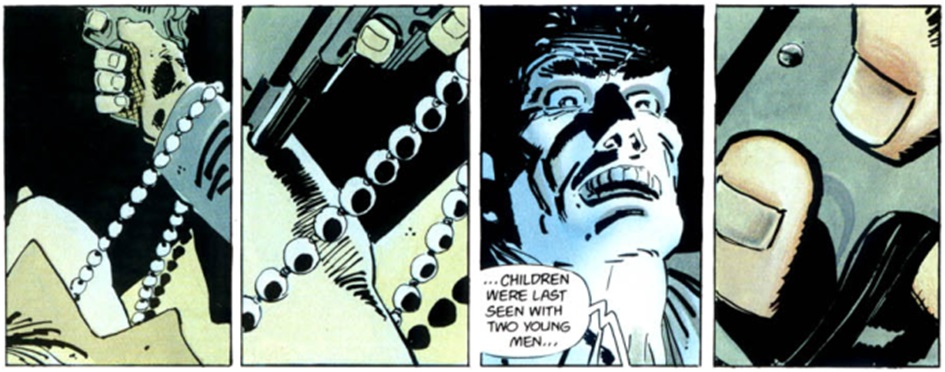
Another flashback shows the young Bruce falling into the Batcave and being swarmed by bats. This is another scene lifted from The Dark Knight Returns. The film strays from the comic by having Bruce fall into the cave on the date of his parents’ funeral, rather than during a time when they’re still alive; a revision first explored in Joel Schumacher's Batman Forever (1995).
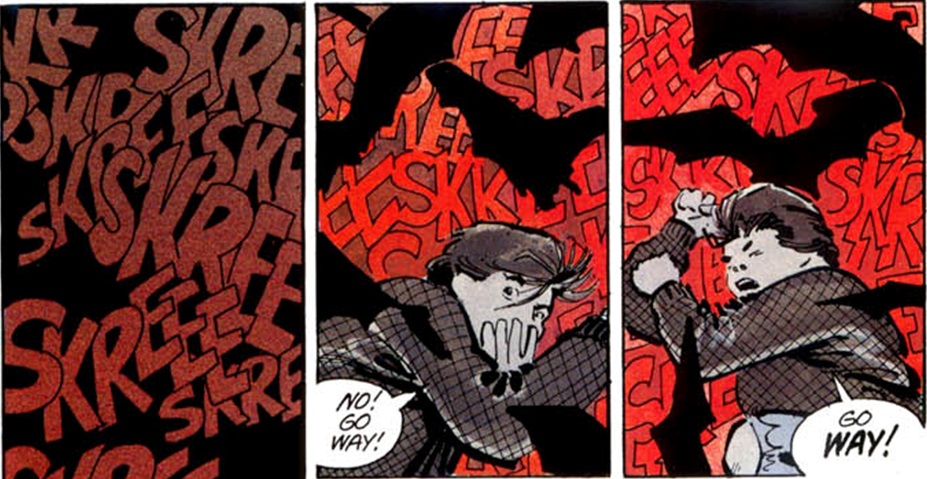
Ben Affleck offers a strong physical match for the Bruce Wayne in the comics. He has black hair and a square jaw like his comic book counterpart. And he’s the first actor to play the role who is actually taller than the Batman in the comics – Bruce Wayne is meant to be 6’2, while Affleck stands at around 6’3.
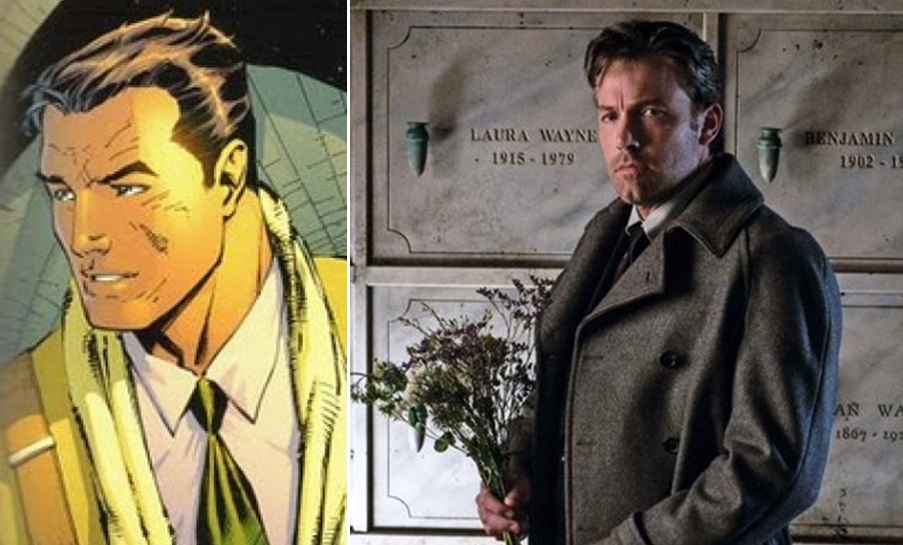
In addition to matching Bruce’s height and facial characteristics, Affleck also built up his physique to mirror that of the comic book Batman.
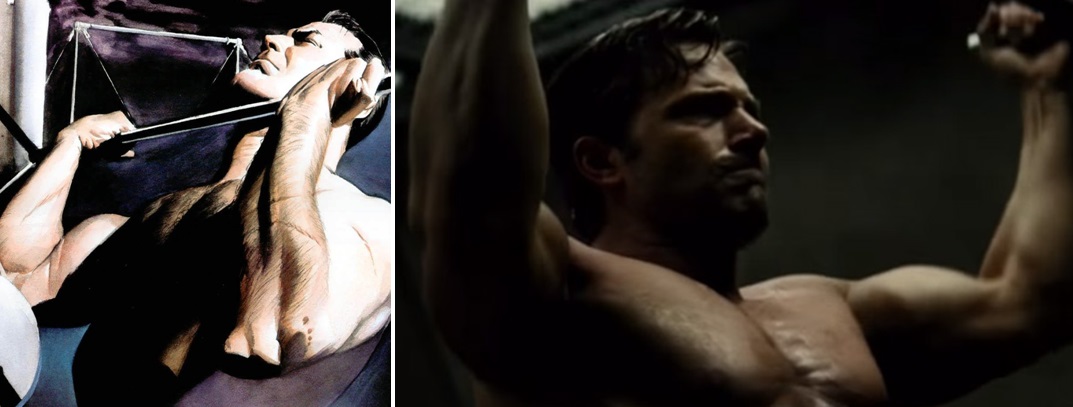
His main costume in the film is visually inspired by The Dark Knight Returns suit, specifically the grey and black design that debuts in the second chapter. The chest emblem is taken directly from this story, as is the design of the cowl with its shorter ears. The hulking musculature of the suit reflects Batman’s heavyset build in that story. The armoured texture of the costume and the lack of trunks reflect the New 52 costume from contemporary comics.
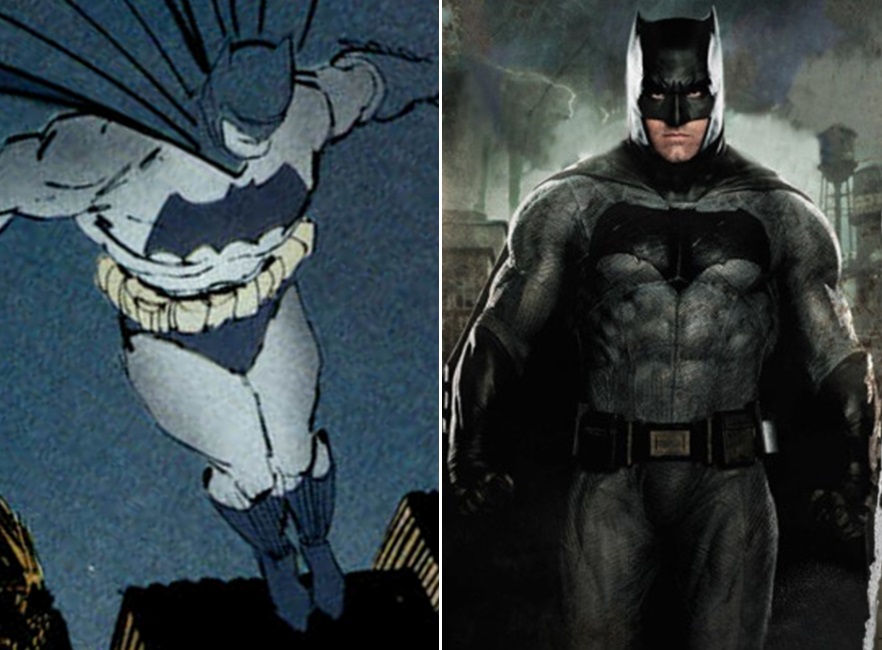
Bruce Wayne is depicted as being older than Clark Kent in this film. The age disparity between them has its basis in The Dark Knight Returns, where Bruce was in his mid-fifties while Clark had physically remained in his thirties due to his Kryptonian physiology.
The idea of a younger Superman battling an older Batman may also have been inspired by Batman/Superman: Cross World (Batman/Superman Vol 1 #1-5, August-December 2013, Justice League Vol 2 #23.1, November 2013), in which the young New Earth Superman from the New 52 canon travelled to Earth 2 and encountered an older, more experienced Batman. The Elseworlds story Superman: Red Son (2003) presents an inverted take on this age disparity, where a young Batman battles an older, more experienced Superman.
Bruce’s only friend and confidante in the movie is Alfred Pennyworth, played by Jeremy Irons. Alfred first showed up in the Golden Age story ‘Here Comes Alfred’ (Batman Vol 1 #16, April 1943).
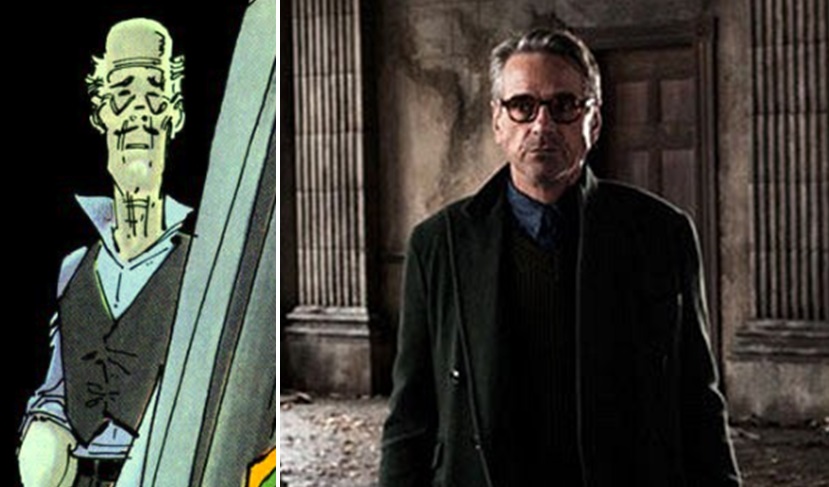
In the comics, Alfred had served in the British armed forces before becoming a butler. At one point in the film Alfred can be seen wearing a navy blue jumper with shoulder epaulettes, suggesting he too may have a background in the military. Alfred is shown aiding Bruce from the Batcave while Batman is out fighting crime, monitoring his actions and supplying him with intel using the hi-tech apparatus in the cave. Alfred often helps Batman in a similar capacity in the comics.
Irons’ Alfred also displays the same sarcastic, dry sense of humour as his comic book counterpart. At one point he comments on the next generation of Waynes facing an empty wine cellar before correcting himself on the possibility of there ever being a next generation. This line is lifted directly from The Dark Knight Returns.
Wayne Manor appears in the film as a dilapidated ruin, having apparently burned down sometime prior to the events of the movie. Bruce is living in a lakeside house nearby, with no apparent interest in rebuilding his ancestral home. This is similar to Kingdom Come (1996), where Wayne Manor had been burned down by Two-Face and Bane, and Bruce had resigned himself to living in the caves beneath its ruins. Something similar also happens at the end of The Dark Knight Returns, where the house burns down and Bruce establishes his new home in the caves underneath.
Amongst the graves situated on the estate of Wayne Manor is a headstone for Solomon Wayne, one of Bruce’s ancestors from the comics.
Affleck’s Batman is portrayed as a burned-out cynic who has abandoned the lofty ideals of his younger self. When Alfred hints at this change in his character, Bruce responds: “We’re criminals. We’ve always been criminals.” This is actually a line from The Dark Knight Returns (and was repeated in All Star Batman & Robin, the Boy Wonder) that an older Bruce had said to the Justice League shortly before they were disbanded.
While this darker characterisation is largely inspired by The Dark Knight Returns, it also evokes the Thomas Wayne Batman of the Flashpoint universe. He too lost everything dear to him and adopted a zero tolerance approach to crime that included killing criminals. The Affleck Batman’s use of lethal force also harkens back to the original Golden Age Batman, who regularly killed villains during the earliest period of his career.
The Batcave in the film contains all the usual crime fighting amenities from the comics. One item of particular interest is a glass cabinet containing the costume of Batman’s late sidekick, Robin. This is yet another detail lifted from The Dark Knight Returns.
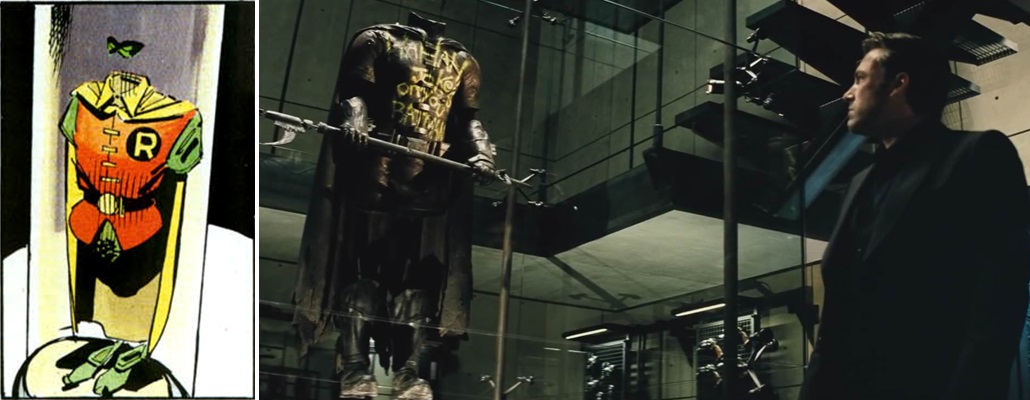
Also in the cabinet is a staff-like weapon. This might be a reference to the bō staff used by the Tim Drake Robin in the comics. The taunting message on Robin’s costume might have been inspired by the message the Joker left Batman after he murdered Jason Todd in Batman: A Death in the Family (1989).
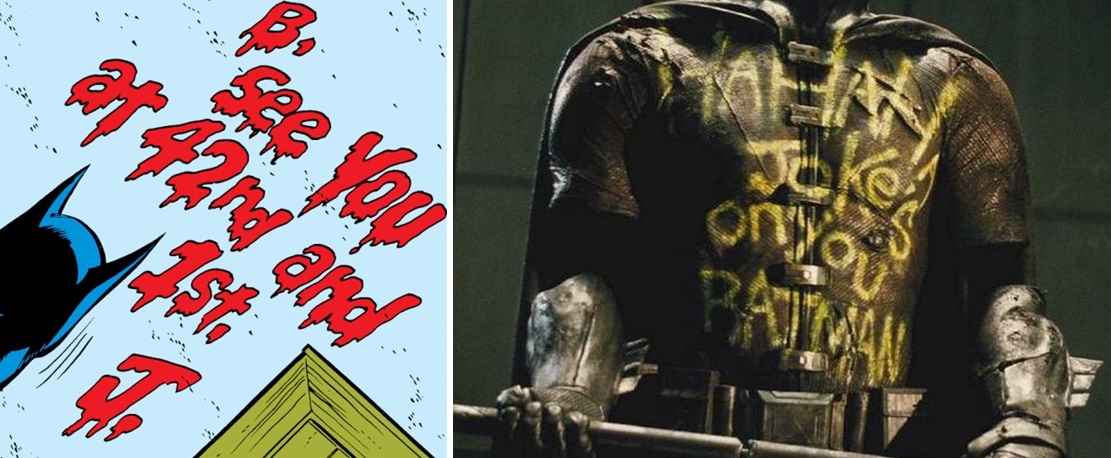
Bruce references the Joker during his first conversation with Clark Kent: “Maybe it’s the Gotham City in me, but I just have a bad history with freaks dressed like clowns.”
Much like in the comics - specifically Batman: Year Three and A Lonely Place of Dying - Batman became more brutal in the wake of Jason Todd's death. His exact methods, however, come from other sources.
While the "Bat Branding" in the film might not have precedence in the comics, it may well have been inspired by the very first live-action Batman: Lewis Wilson. In the 1943 serial The Batman, which also contained the first appearance of the Batcave, Wilson's Batman would mark criminals with a bat insignia before handing them over to the police. Though he presumably used ink instead of a hot iron.
Another possible influence is the unproduced script for Batman: Year One by Darren Aronofsky and Frank Miller. In this version, a young Bruce Wayne wears his father's signet ring while fighting crime. The initials TW were designed in such a way that when he punched the ring into criminals, the impact would leave a bat-shaped impression.
The cops who find the bat-branded criminal are named Mazzuchelli and Rucka in the credits; presumably named after David Mazzuchelli (who drew Batman Year One) and Greg Rucka (who wrote several Batman stories and worked on Gotham Central).
The security hand scanner for the vault that houses the batsuit is very similar to the technology used by Batman in the Injustice: Gods Among Us video game.
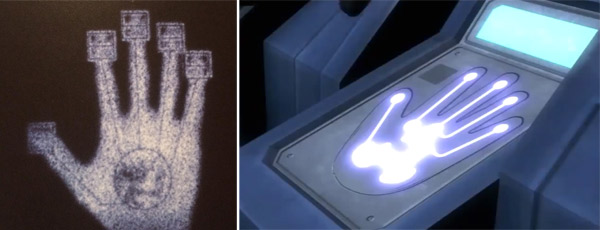
Henry Cavill reprises his role as Clark Kent/Superman from Zack Snyder’s Man of Steel (2013). At 6’1, Cavill is only 2 inches shy of Superman’s height in the comics. His dark hair, blue eyes and chiselled features are very much in line with those of the comic book Superman, as is his muscular physique. His costume mirrors the New 52 design seen in contemporary comics, retaining the blue bodysuit, red cape and boots, but ditching the red trunks and yellow belt featured in older designs.
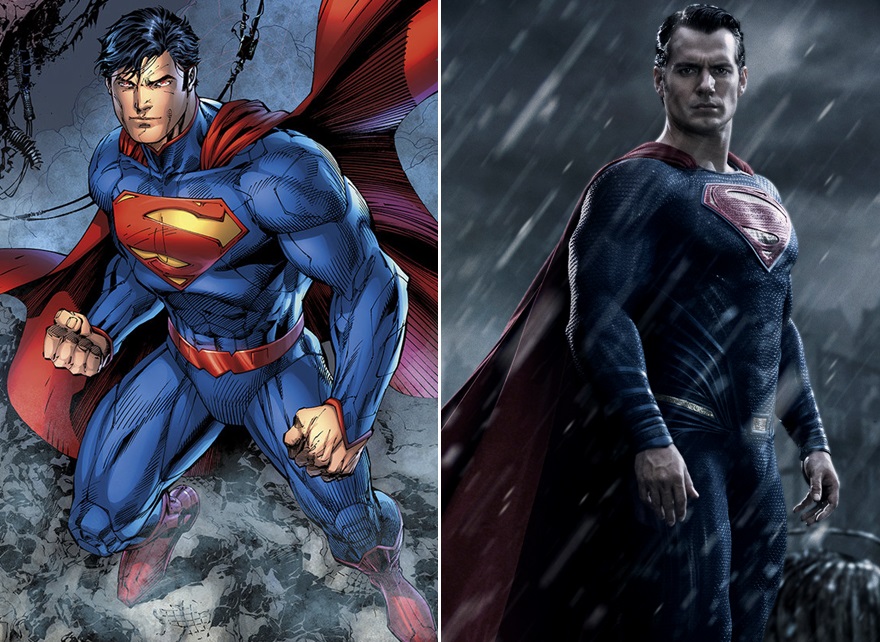
His hair is usually gelled back in a manner resembling the Alex Ross Superman. However he does finally get his trademark spit curl during the battle in the rain, where a few strands of his hair fall down over his forehead.
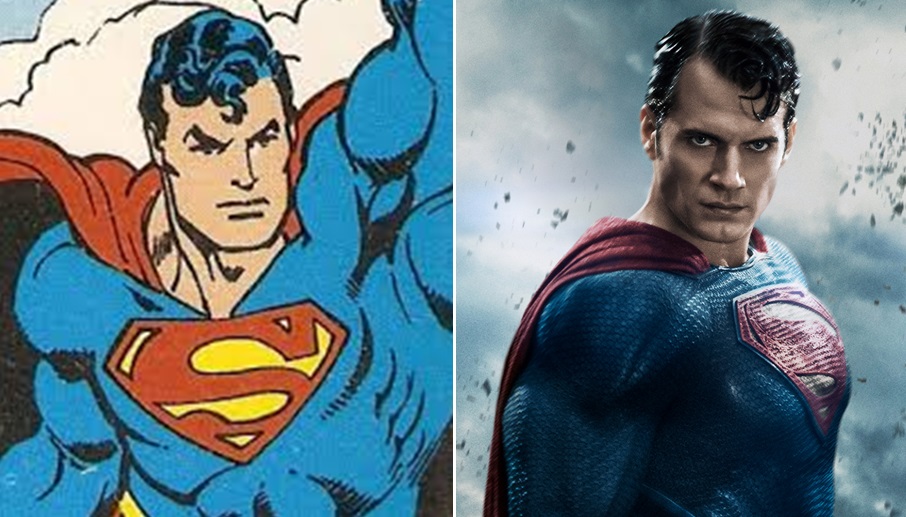
Another character to appear from the Superman comics is Lois Lane, played by Amy Adams. Like Clark, Lois made her debut back in Action Comics Vol 1 #1 (June 1938).
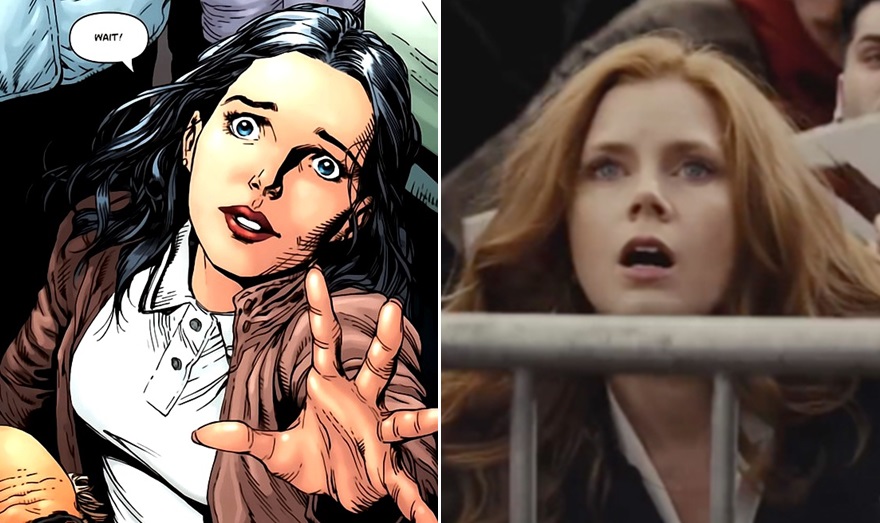
The film contains a subtle allusion to the publication date of Action Comics #1 where Perry White says, “It’s not 1938 anymore.” Perry himself first appeared in ‘The Three Kingpins of Crime’ (Superman Vol 1 #7, November 1940) and is played here by Laurence Fishburne.
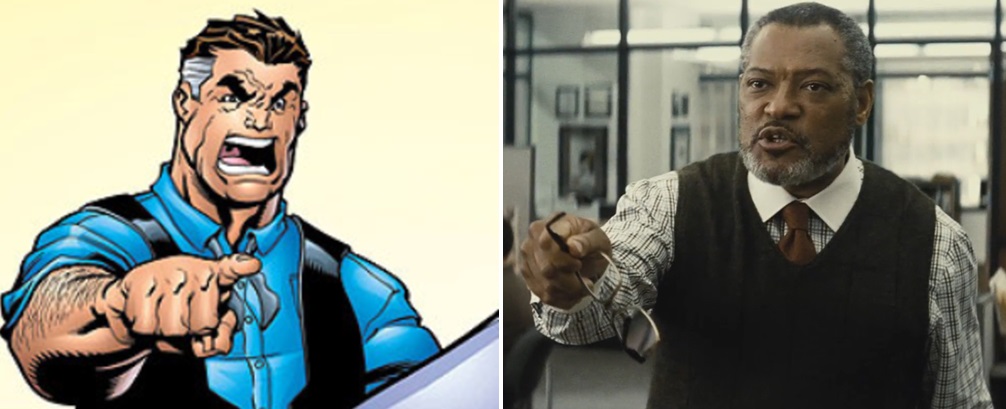
Another character to return from Man of Steel is Martha Kent, played by Diane Lane. Martha first appeared in ‘Clark Kent Gets a Job’ (Superman Vol 1 #1, June 1939). Back then she was known as Mary Kent.
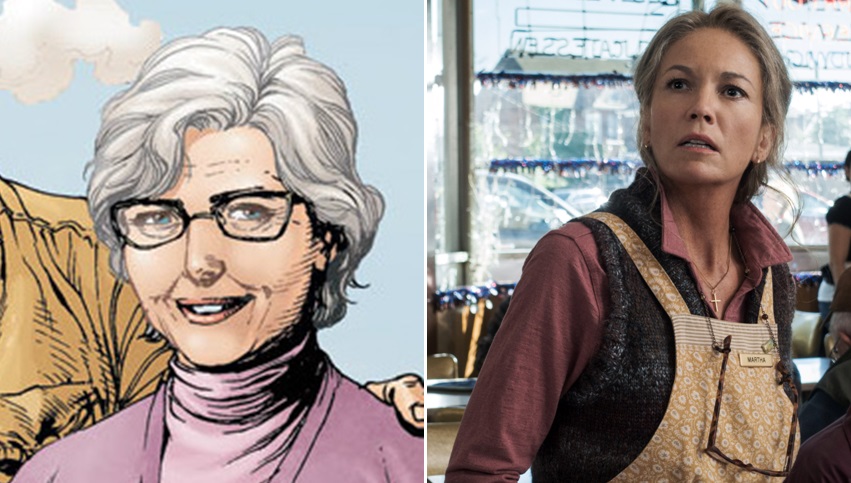
Jonathan Kent (Kevin Costner) also appears in the form of a vision. He too made his debut in Superman Vol 1 #1.
Although his name is never spoken during the film, the CIA agent who gets killed during the scene in Africa is meant to be Jimmy Olsen. However, the only thing he has in common with his comic book namesake is his camera. Beyond that, there’s nothing else taken from the comics. So the use of Olsen’s name here is more of an Easter egg than a proper adaptation of the character.
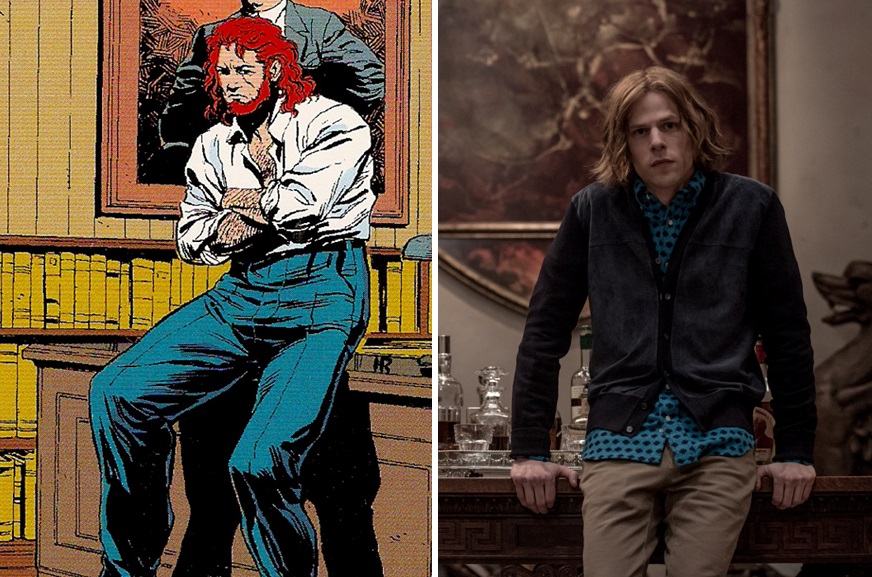 The principal antagonist in the film is Lex Luthor, played by Jesse Eisenberg. This character is identified as Alexander Luthor Jr, son of the original Lex Luthor. In the comics, Lex Luthor Jr was actually a clone body that the original Lex had his brain transplanted into when his old body died. The public believed this new Luthor was the son of the original, allowing Lex to create a new legitimate public persona for himself. This meant he could socialise with his enemies without them realising who he truly was, much as the Eisenberg Lex is shown doing in the film.
The principal antagonist in the film is Lex Luthor, played by Jesse Eisenberg. This character is identified as Alexander Luthor Jr, son of the original Lex Luthor. In the comics, Lex Luthor Jr was actually a clone body that the original Lex had his brain transplanted into when his old body died. The public believed this new Luthor was the son of the original, allowing Lex to create a new legitimate public persona for himself. This meant he could socialise with his enemies without them realising who he truly was, much as the Eisenberg Lex is shown doing in the film.
Lex Luthor Jr also sported a full head of long wavy red hair like the Eisenberg version. He was the version of Lex in the comics throughout the Death of Superman arc.
Alternatively, Alexander Luthor Jr may have been inspired by the Earth-Three character of the same name, who really was the son of Lex Luthor (albeit the heroic Earth-Three version). This version of Lex Jr made his debut during the events of Crisis on Infinite Earths, which is another story referenced in Snyder’s film.
Lex’s appearance in the movie – clean-shaven with long wavy red hair – may have been inspired by his youthful look in Superman: Birthright (2003-2004).

Lex is the first villain in the DCEU to get his hands on Kryptonite. In Superman: Secret Origin (2009-2010), the teenage Lex was the first person to expose Clark to Kryptonite during his Smallville years. However this version of Lex had yet to turn villainous and didn’t know the effect the radioactive meteorite would have on his friend. Whereas in the film he’s very much aware of its lethal properties.
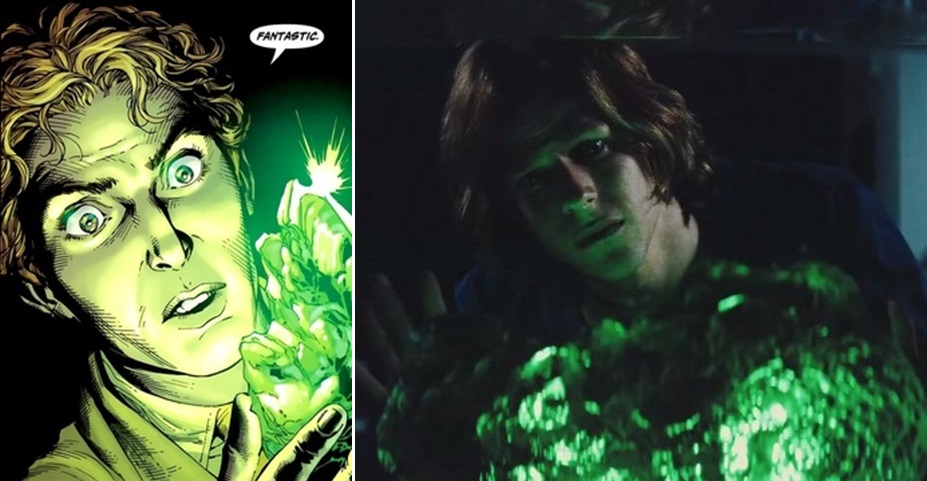
Lex’s scientist who investigates the Kryptonite is identified on the credits as Emmet Vale (played by Ralph Lister). Vale is the character who first discovered Kryptonite in the Post-Crisis canon, as depicted in 'From Out the Green Dawn' (Man of Steel #1, October 1986). He is best known in the comics for creating the villainous cyborg Metallo.
Lex’s personal assistant in the movie is Mercy Graves (Tao Okamoto), a character who originally debuted in the Superman: The Animated Series (1996-2000) episode ‘A Little Piece of Home’ (season 1, episode 5) and was later adapted into the comics. In the comics it is implied that Mercy is an Amazon. But in the movie she appears to be an ordinary human. Much like in the New 52 comics, this Mercy is depicted as Asian.
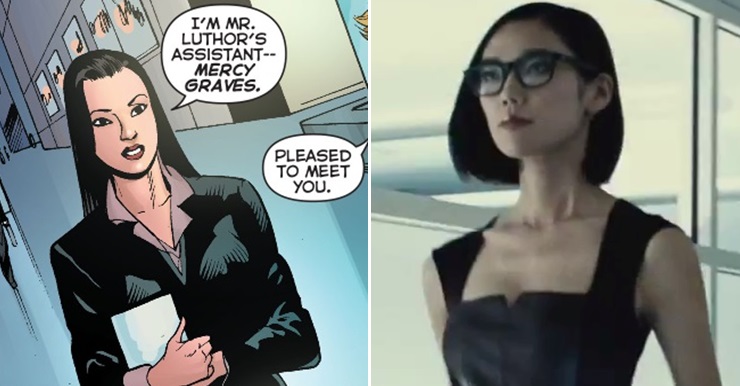
Another villain in the film is Anatoli Knyazev, played by Callan Mulvey. Better known in the comics by his alias KGBeast, this character first appeared in ‘Ten Nights of the Beast!’ (Batman Vol 1 #417, March 1988). Beyond his name, Russian accent and status as a mercenary, the movie version doesn’t bear much resemblance to the character in the comics.
A Superman statue has been erected in Metropolis since the events of Man of Steel, much like the one from the comics.
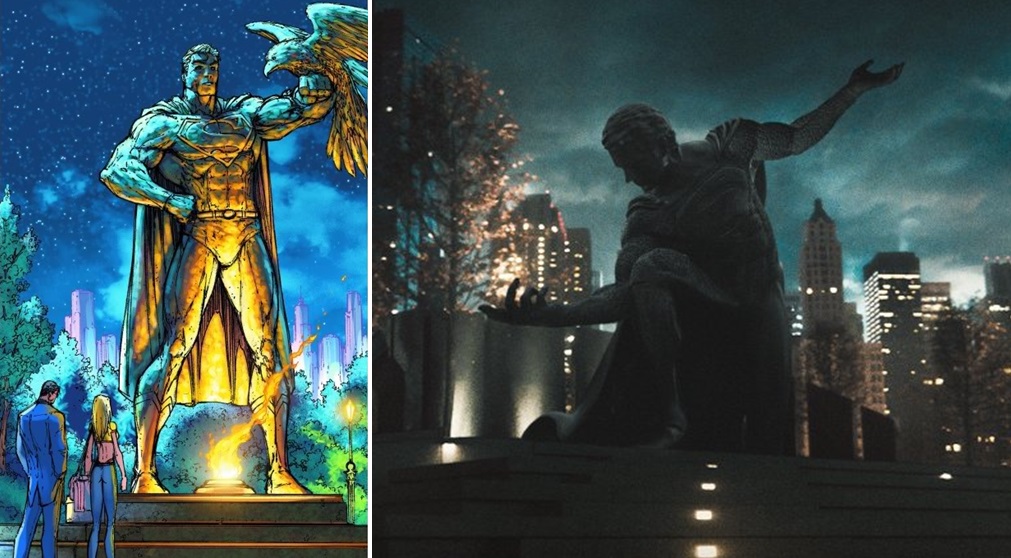
While attending a social event, Bruce meets Diana Prince (Gal Gadot). This marks the big screen debut of Wonder Woman, who first appeared in the comics back in ‘Introducing Wonder Woman’ (All-Star Comics Vol 1 #8, December 1941).
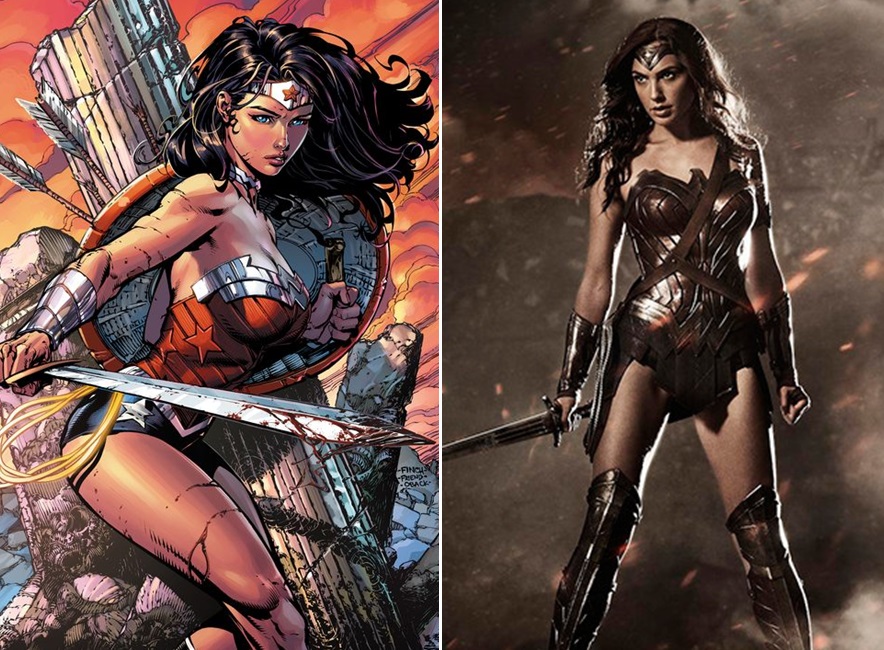
The party sequence is followed by a montage of Superman rescuing people from various hazards. This includes him saving a child from a burning building, hauling a ship through some ice by a chain (in the comic, he hauls a raft of survivors during a flood), and rescuing flood victims who are marooned on their rooftops. All of these scenes are taken from Alex Ross and Paul Dini’s Superman: Peace on Earth (1999).
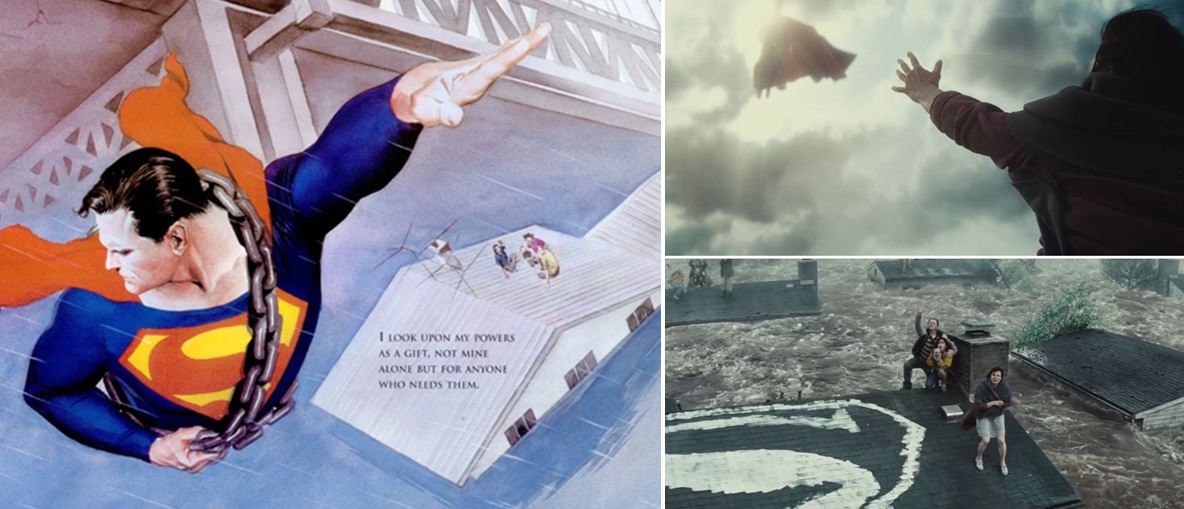
The scene of the crowd reaching out to touch Superman may also have been inspired by this story.
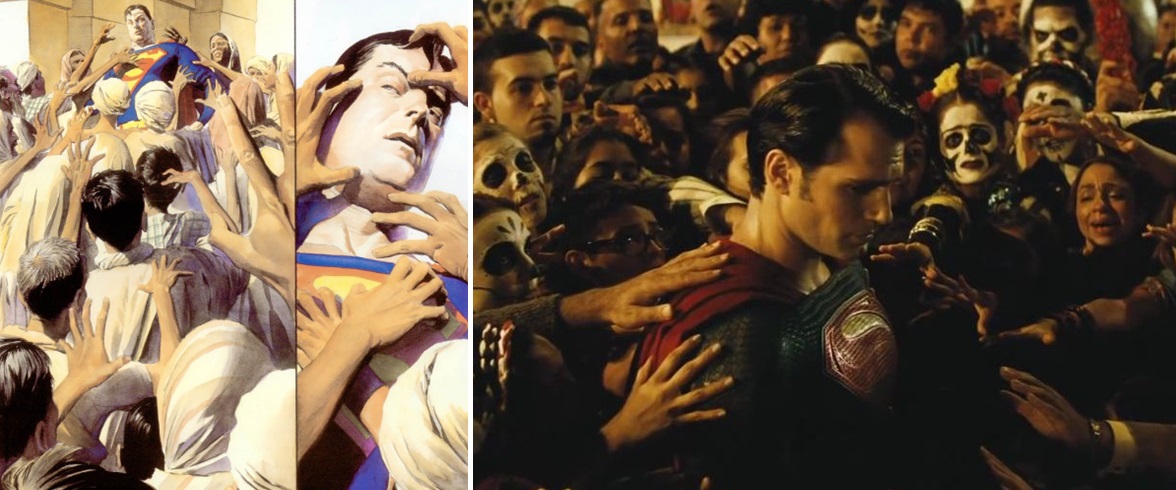
Following his encounters with Clark and Diana at Luthor's party, Bruce returns to the Batcave and experiences a ‘Knightmare’ vision. This sequence contains several nods to Jack Kirby’s Fourth World mythos. The first one to note is the omega symbol on the ground, which is the emblem of Darkseid. The second is the large pillars of flame erupting from the planet’s surface, which are similar to those seen on Apokolips.
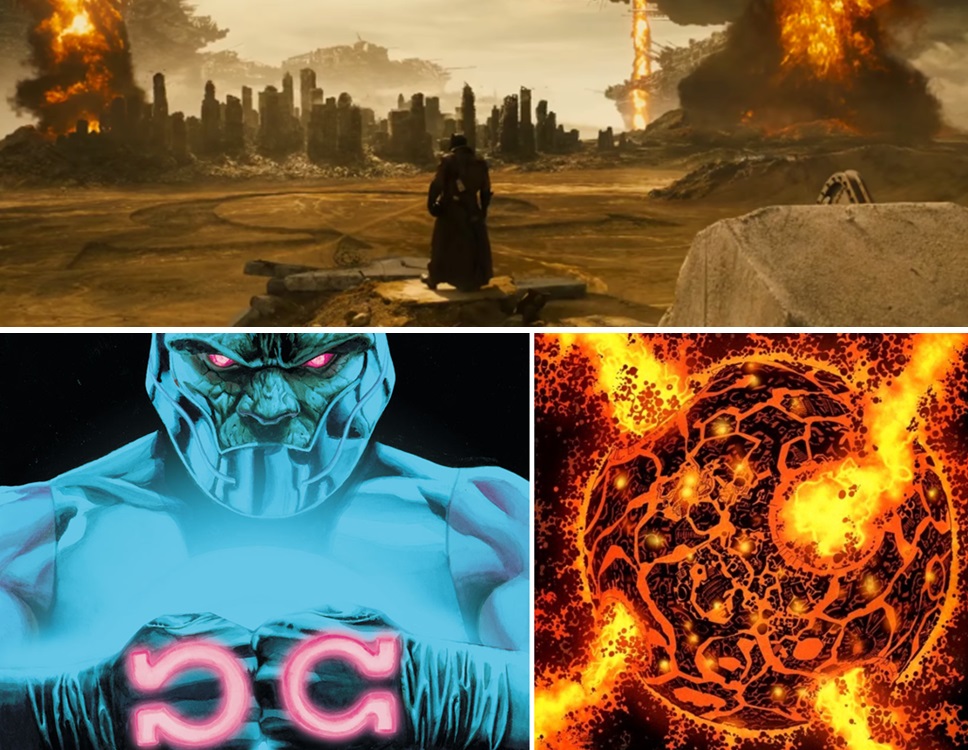
Batman’s clothing in this scene evokes some of the outfits he’s worn in Elseworlds books. Most notably the Victorian Batman’s costume from Gotham by Gaslight (1989) and the WWII Batman’s costume from JSA: The Liberty File (2000).
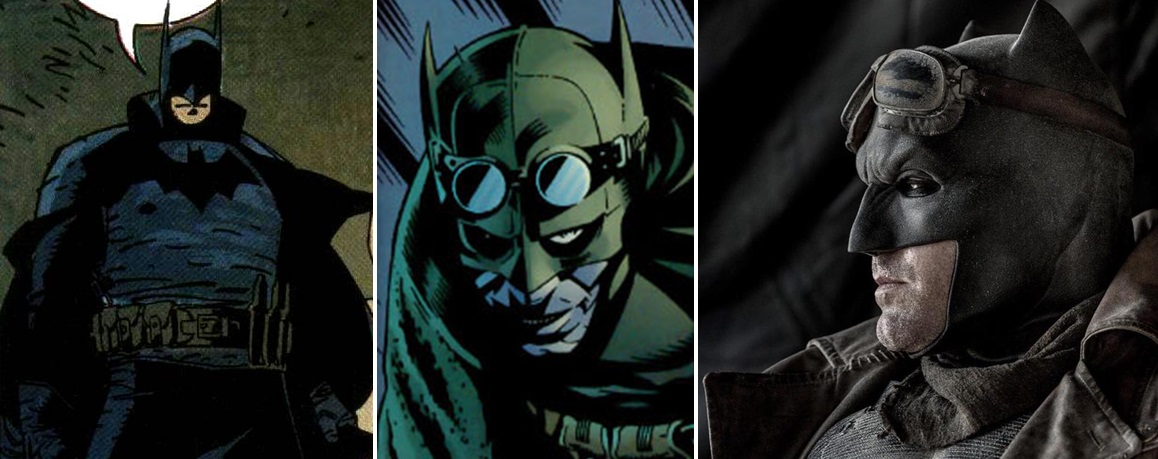
The winged creatures that attack Batman are Parademons, Apokoliptian soldiers commanded by Darkseid.
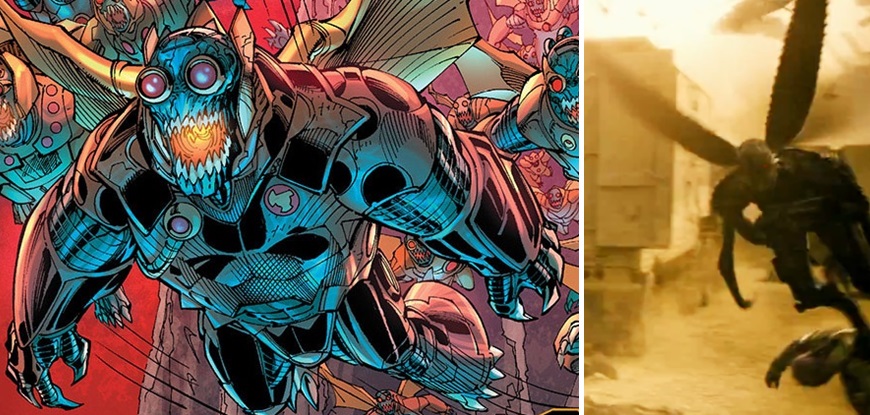
The armoured soldiers who bow before Superman resemble the Regime Soldiers from the Injustice universe.
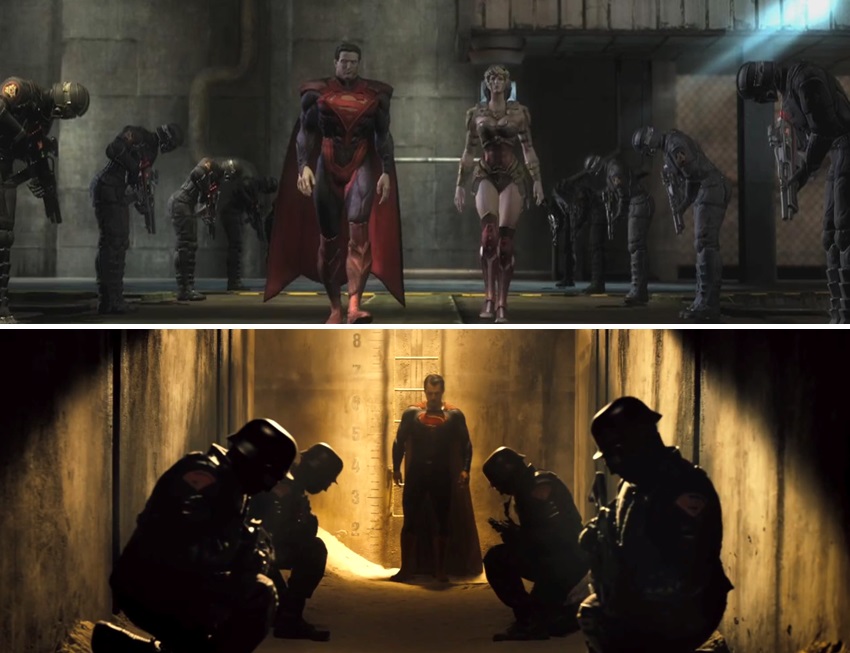
At the end of the ‘Knightmare’ sequence, Superman kills Batman by pushing his hand through his chest. This is the same method the Injustice Superman used to kill the Joker in Injustice: Gods Amongst Us #2 (April 2013). Superman’s cryptic words prior to killing Batman would suggest he has turned evil after losing Lois Lane. This was the same catalyst that turned the Injustice Superman down the dark path.
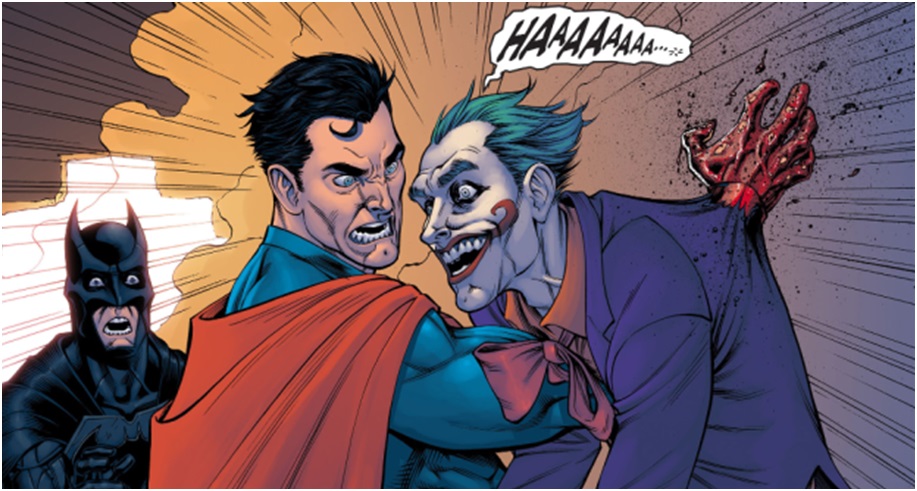
Immediately following the ‘Knightmare’ sequence, Bruce experiences a vision in which the Flash emerges from some sort of temporal rift and delivers a cryptic warning from the future. This scene would appear to have been inspired by a similar moment from Crisis on Infinite Earths (1985-1986) where the Flash travels back in time to warn Batman about the impending threat posed by the Anti-Monitor.
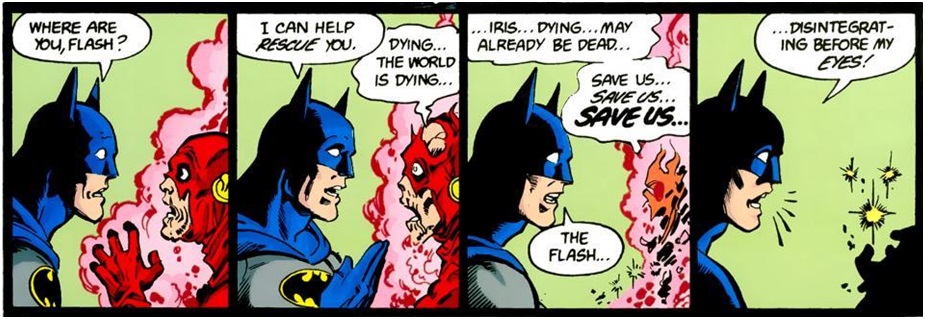
The idea of a hero travelling back in time from a post-apocalyptic future also recalls the 'Armageddon 2001' (1991) crossover event, where Waverider travelled back from a totalitarian version of the year 2030 in which Earth had been devastated by the villain Monarch. Monarch had laid waste to Earth’s heroes and conquered the planet, much as Superman and Darkseid are implied to have done during the 'Knightmare' vision. In the comic, Waverider suspects Monarch was a former hero and so travels back in time to discover his true identity. Superman and Batman are amongst those investigated. So as in the movie, we have a character travelling back in time from a post-apocalyptic future and identifying one of the heroes in the present as the catalyst for said apocalypse.
While we’re on the subject of this particular crossover event, there’s another parallel worth noting. In ‘Execution 2001’ (Superman Annual Vol 2 #3, 1991) Waverider sees a future in which Superman, embittered by the loss of Lois Lane and the destruction of Metropolis, embarks on an aggressive campaign of nuclear disarmament without the consent of Earth’s governments. His militant actions result in the deaths of several innocent people, including Martian Manhunter. The story ends with Batman donning hi-tech armour similar to that featured in The Dark Knight Returns and battling Superman one-on-one. Batman tries reasoning with Superman, but the latter’s mind has become unhinged. The duel ends with the Dark Knight killing the Man of Steel using a kryptonite ring.
So the idea of Lois’ death pushing Superman along a path of villainy is one that’s been explored in numerous ‘what if’ scenarios over the years.
Bruce obtains some secret files containing information about the existence of metahumans. Each of these file entries gives us a glimpse of another DC hero and we get a closer look when Diana opens them later on.
We were already briefly introduced to the Flash (Ezra Miller) when he appeared before Bruce earlier in the film. We now get a better look at him via security footage as he foils a convenience store robbery using his super speed. This version of the Flash is based on the Barry Allen incarnation who debuted in ‘Mystery of the Human Thunderbolt!’ (Showcase Vol 1 #4, October 1956).
There’s also a file on Wonder Woman which includes a black & white photograph from 1918. In the picture, Wonder Woman is depicted standing beside Steve Trevor (Chris Pine). Like Diana, Steve debuted in All-Star Comics Vol 1 #8.
Another file contains underwater footage of Aquaman (Jason Momoa), who first appeared in ‘The Submarine Strikes’ (More Fun Comics #3, November 1941). While the traditional Aquaman is clean-shaven and wears an orange suit, this incarnation is visually closer to the nineties version, who was depicted shirtless, long haired and bearded.
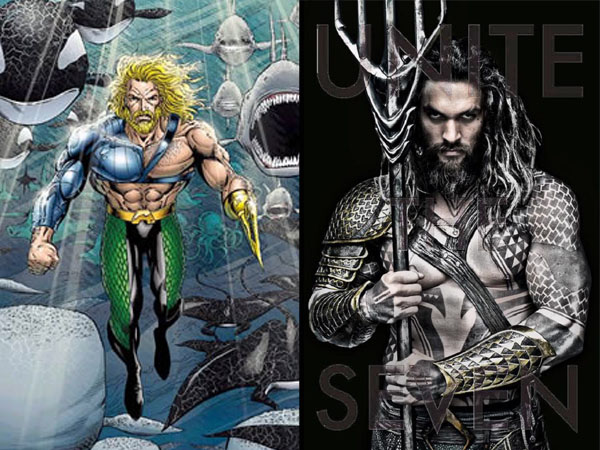
The fourth file depicts Victor Stone (Ray Fisher) and his father Silas (Joe Morton). In the comics, Victor’s body was horribly damaged during a lab experiment gone wrong. He was then rebuilt by his father into the superhero Cyborg. Both Cyborg and Silas Stone made their debuts in ‘Where Nightmares Begin!’ (DC Comics Presents Vol 1 #26, October 1980). In the film, Victor’s fateful accident is related to a Mother Box. This recalls Cyborg’s New 52 origin where his body was damaged by an explosion caused by a Father Box, as depicted in Justice League Vol 2 #2 (December 2011).
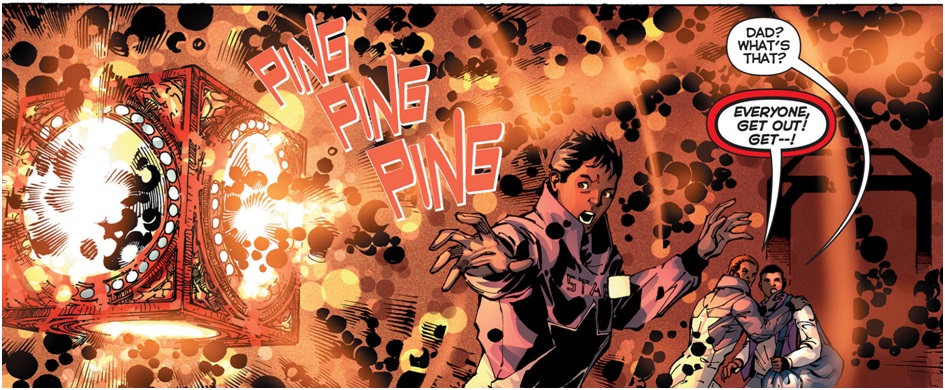
Mother Boxes are supercomputers originating on the planet New Genesis. They were first introduced in Jack Kirby’s Forever People Vol 1 #1 (March 1971), which was the same issue in which Darkseid made his debut.
Mother Boxes also appear during a deleted scene involving Lex and a mysterious figure that appears before him aboard the wreckage of the Kryptonian scout ship. It’s not entirely clear which character this apparition is meant to represent, but it’s most likely a figure from Jack Kirby’s Fourth World mythology. Two possible candidates include:
- Yuga Khan, former ruler of Apokolips and father of Uxas (aka Darkseid)
- Steppenwolf, brother-in-law of Yuga Khan and uncle to Uxas/Darkseid
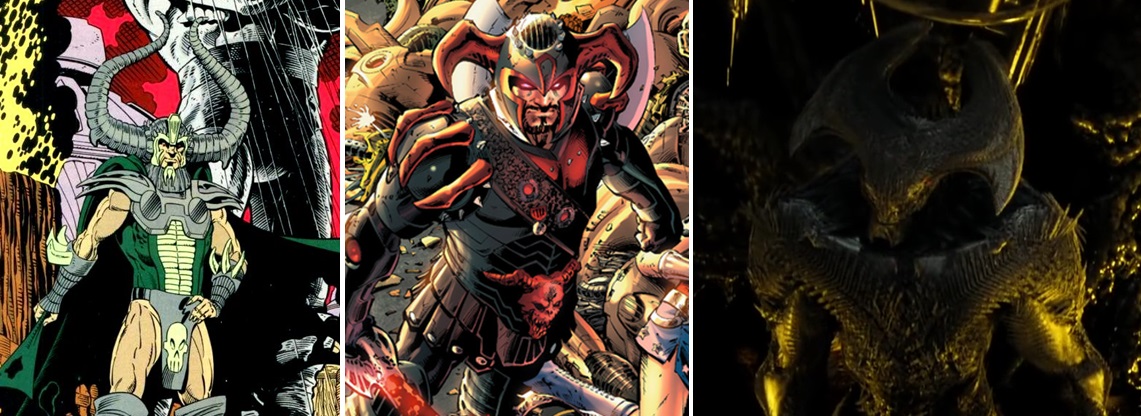
Wonder Woman, the Flash, Aquaman and Cyborg were all founding members of the Justice League in the New 52 canon. It appears they will be in the DCEU canon too.
The scene where Batman stands atop an elevated structure with a rifle is visually similar to a scene from The Dark Knight Returns. In both stories Batman is applying the rifle to a non-lethal purpose: in The Dark Knight Returns he uses it to deploy a cable, while in the movie he uses it to attach a tracking device to a vehicle.
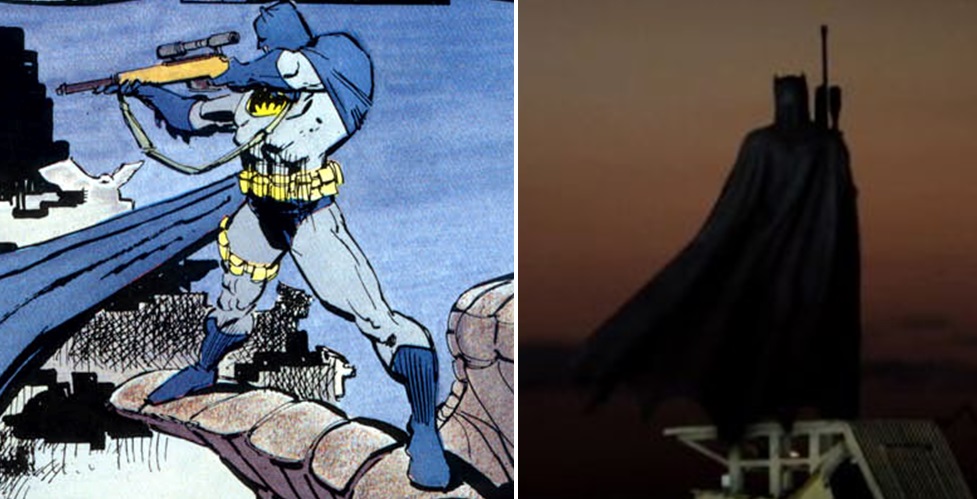
Shortly after putting a tracking device on the truck, Batman chases after Lex Luthor's men in the Batmobile. The Batmobile first appeared in the comics in Detective Comics #27 (1939). It was originally a red sedan, but gradually evolved into a bat-themed automobile as the years went by. More recently, it has been depicted as a heavily armoured assault vehicle. Much like the previous incarnation of the Batmobile in Christopher Nolan's Dark Knight Trilogy, this model is outfitted with machine guns and is shown crashing through heavy obstacles with ease. In the middle of the chase, Batman crashes into Superman and the two confront one another for the first time in costume.
Later, Superman addresses Congress at the Capitol Building in Washington D.C. The imagery in this scene echoes yet another moment from Superman: Peace on Earth.
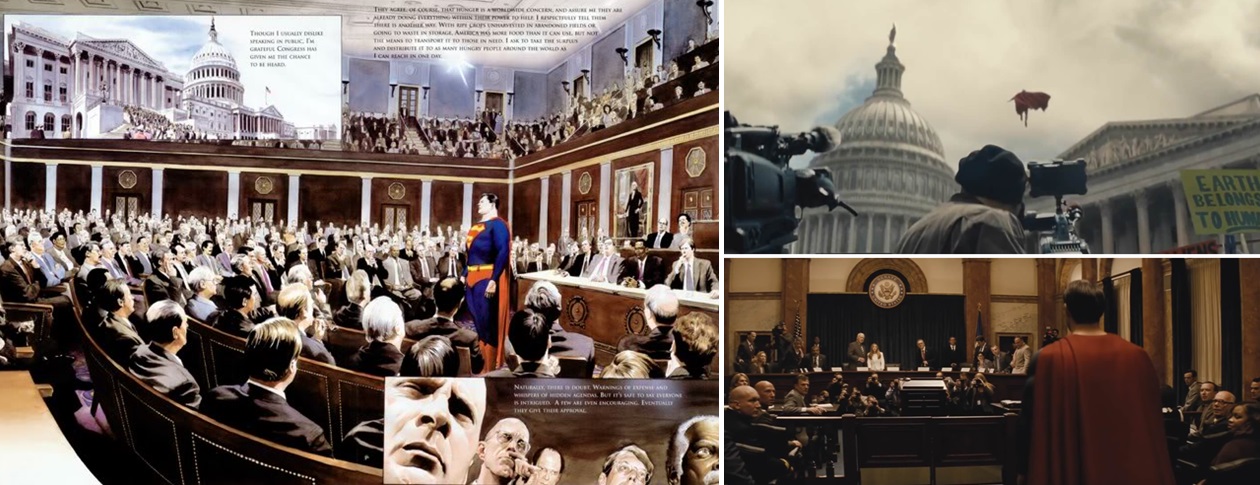
The Capitol is blown up, however, and an enraged Bruce Wayne dons a special armoured Batsuit for his showdown with Superman. This is taken from The Dark Knight Returns.
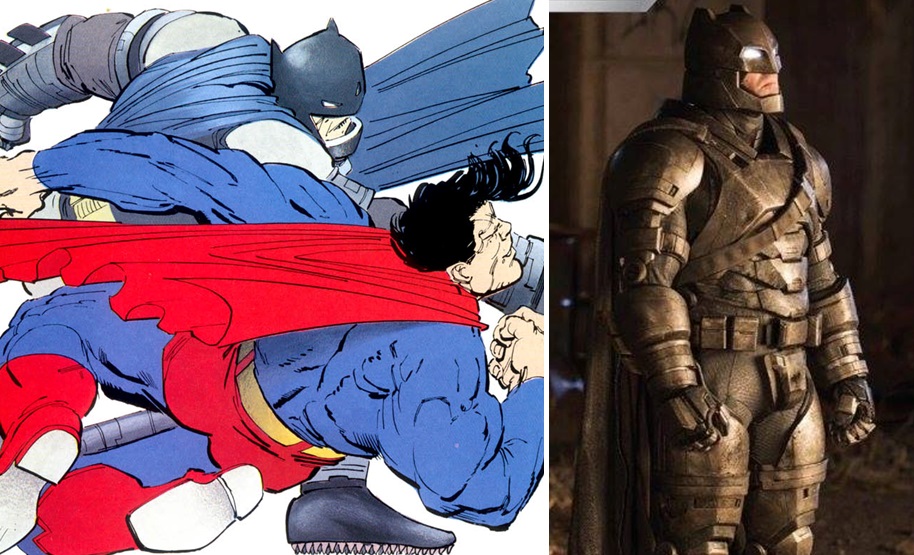
A question mark can be seen on a stone pillar during the sequence where Batman hides the Kryptonite spear. This might be a nod to the Riddler.
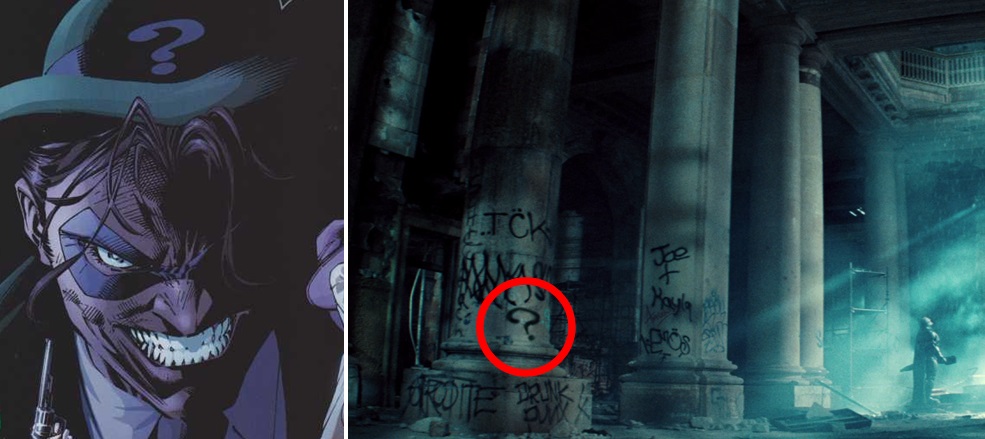
The image of Batman standing beside the Bat-Signal wearing a hi-tech armoured suit is strikingly similar to a scene from Batman Versus Predator (1991). In both stories, Batman is using the signal to summon a powerful adversary to a duel.
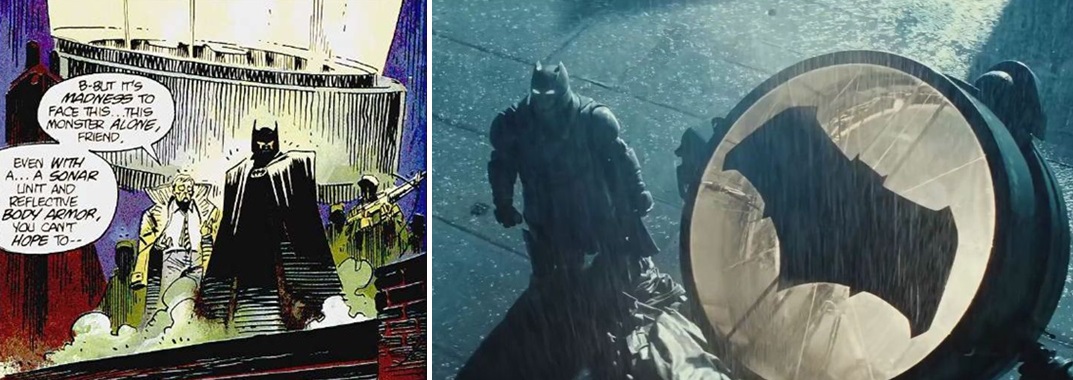
The duel itself is primarily adapted from The Dark Knight Returns. As in the comic, Batman kicks off the fight using a sonic weapon to attack Superman’s super hearing.
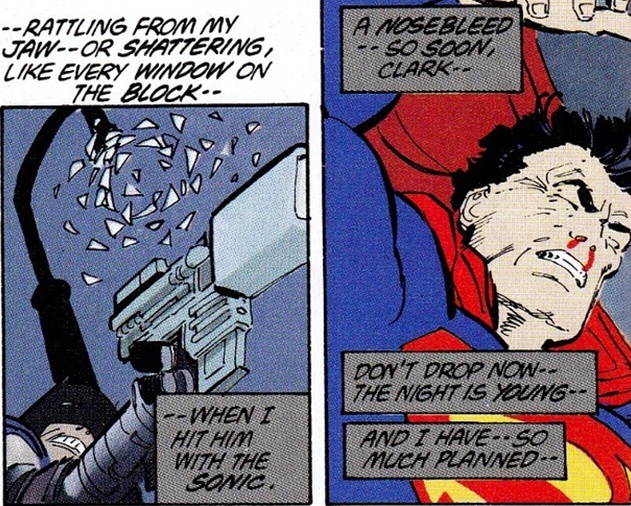
Batman opens fire with a rifle, only for Superman to catch the shell and have it detonate in his face, engulfing him in Kryptonite gas. In the comic it was Green Arrow who fired the capsule containing the gas.
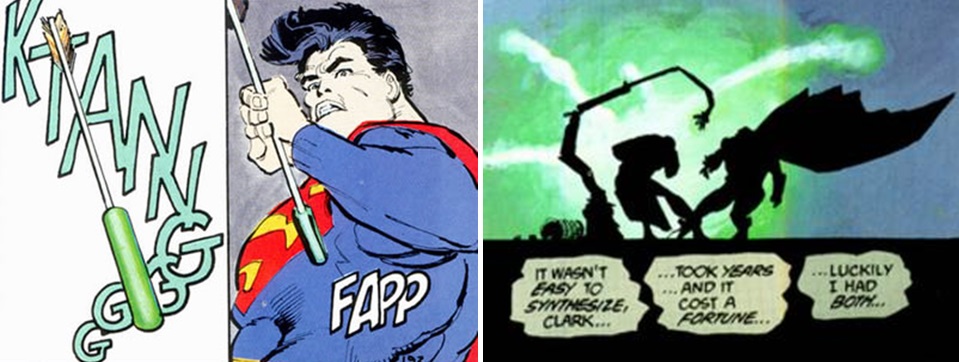
With Superman weakened, Batman is able to unleash a brutal beating on the Kryptonian.
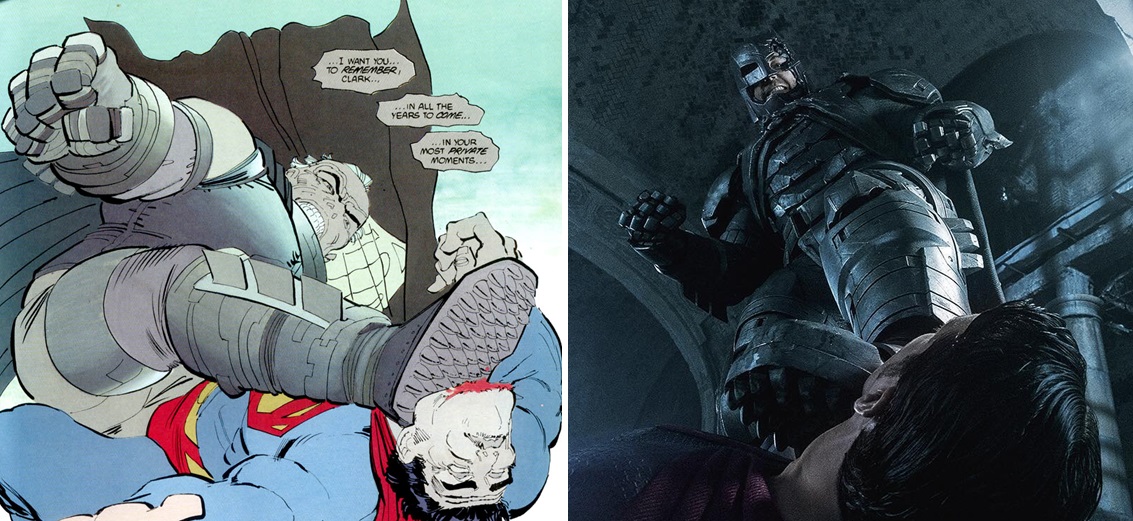
Several lines from The Dark Knight Returns are paraphrased or lifted during the battle, such as "It's time you learned what it means to be a man" and "My parents taught me a different lesson [...] They showed me the world only makes sense if you force it to."

The fight ends when Superman begs Batman to "save Martha," prompting Bruce to stop and remember his own mother. This link between Batman and Superman - where their mothers share a first name - has existed in the comics since the 1950s. While Clark's mother was originally called Mary, she was later renamed Martha in Superboy #12 (1958); presumably by writer William Woolfolk, author of the story 'Superboy's Problem Parents!" Coincidentally, another writer who worked on that Superboy issue (albeit on a separate story) was Batman co-creator Bill Finger. Finger had devised the origin for Batman in 1939, but did not name Bruce's mother Martha until Batman #47 (1948).
Once their quarrel is resolved, Batman promises Superman he will rescue Martha from Lex Luthor’s henchmen. He travels to the warehouse where she is being held using the Batwing. In the comics, the Batwing first appeared as the Batplane in Batman #1 (1940). In a scene reminiscent of that issue (as well as the 1989 Batman film and The Dark Knight Rises), Batman attaches machine guns to the front of the plane and uses them to open fire on his enemy's henchmen, killing them in the process.
The sequence where Batman rescues Martha Kent is heavily influenced by a scene from The Dark Knight Returns. At one point during the fight, Batman smashes through a wall and grabs one of the bad guys, just like he does in the comic.

A standoff ensues where Anatoli Knyazev points a flamethrower at Martha and threatens to kill her. In the comic it was a member of the Mutant gang holding a gun to the head of a kidnapped child. In both stories Batman has a gun pointed at the villain, prompting the criminal to express their willingness to kill the hostage.

Batman calmly says “I believe you” and pulls the trigger. In the comic he doesn’t actually kill the gang member, instead only winging her. But in the movie he shoots the fuel tank on Knyazev’s back and causes it to explode.

During the film’s final act, Lex unleashes his ultimate weapon against Superman: a monster genetically engineered from his own DNA and the remains of General Zod. Lex refers to this creature as Superman’s “doomsday”. Doomsday first appeared in the comics in ‘Here Be Monsters’ (Superman: The Man of Steel Vol 1 #17, November 1992).
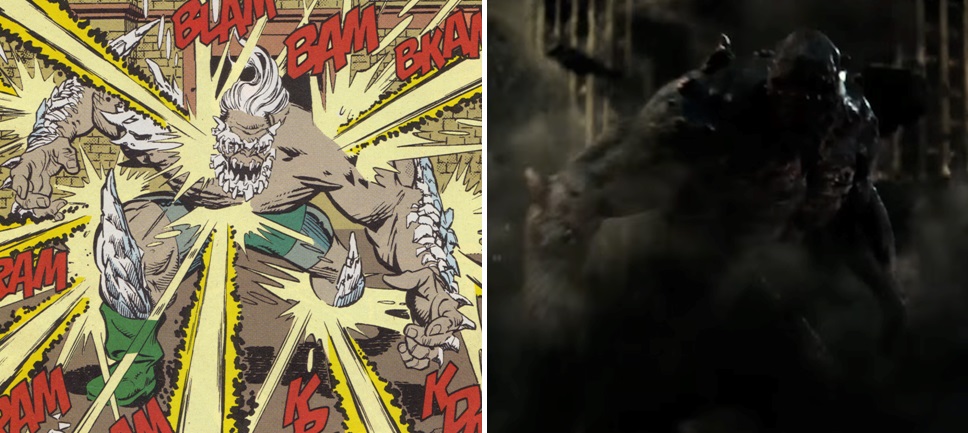
Doomsday’s origins in the comics lie in Krypton’s distance past, where he was created by an alien scientist named Bertron from the body of a child who was killed over and over again. His back story was first depicted in Superman/Doomsday: Hunter/Prey (1994). Like in the comics, Doomsday is created from a corpse. Though in this case, the corpse belongs to General Zod.
During the creation of Doomsday, the Kryptonian computer (voiced by Carla Gugino) identifies Zod as being from the city of Kandor. This Kryptonian city first appeared in Action Comics #242 (July 1958) and is famous for having been shrunken and put in a bottle by Brainiac before Superman stored it in the Fortress of Solitude. Later, in the New Krypton story arc (2008-2009), Kandor was turned into New Krypton and Zod was appointed as its military leader.
While Lex played no role in Doomsday's creation in the comics, he did create Bizarro out of Superman’s Kryptonian DNA in John Byrne’s Man of Steel (1986) miniseries. The idea of a new life form being created by mixing Lex’s DNA with a Kryptonian’s also recalls ‘Teen Titans’ (Teen Titans Vol 3 #1, September 2003), where it was revealed that the Post-Crisis Kon-El Superboy had been created from a mixture of Lex and Superman’s DNA.

Superman initially fights Doomsday one-on-one like he did during the finale of The Death of Superman (1992). He succeeds in taking the battle into orbit by flying Doomsday into space. Superman tried doing this in the original comic, but Doomsday broke free of his grip and plunged back to Metropolis.
Once the battle has shifted to space, the military tries taking out Doomsday with a nuclear weapon. The nuke reduces Superman to a weakened state, during which his appearance adopts a corpse-like thinness and pallor. The same thing happened when he was exposed to a nuclear blast in The Dark Knight Returns. In both stories, he recovers from his weakened state by absorbing energy from the sun.
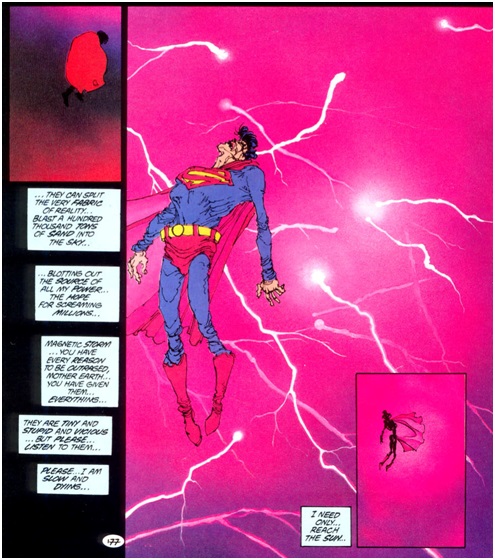
While Superman recovers, Doomsday lands on Stryker's Island. In the comics, Stryker's is a well known penitentiary for dangerous criminals. Its name is derived from Riker's Island, a real prison in New York.
Batman takes the fight to an abandoned area of Gotham, where Superman and Wonder Woman join him. Superman, Batman and Wonder Woman teaming up to fight Doomsday reflects a similar battle in Superman/Batman: The Supergirl from Krypton (Batman/Superman Vol 1 #8-13, May-October 2004). Only in the comic they battled an army of Doomsdays on Themyscira, while in the movie there is only one.
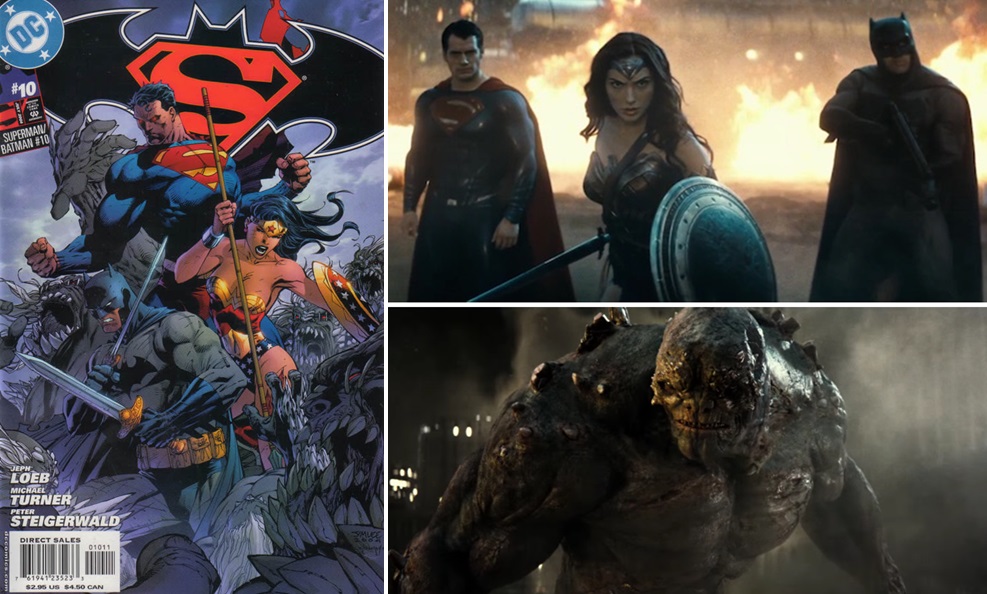
Wonder Woman uses her magic bracelets and Lasso of Truth during the fight. These are two of her signature weapons in the comics.
At one point during the battle, Batman strikes a pose straight off the cover of The Dark Knight Returns, complete with a lightning bolt in the background.
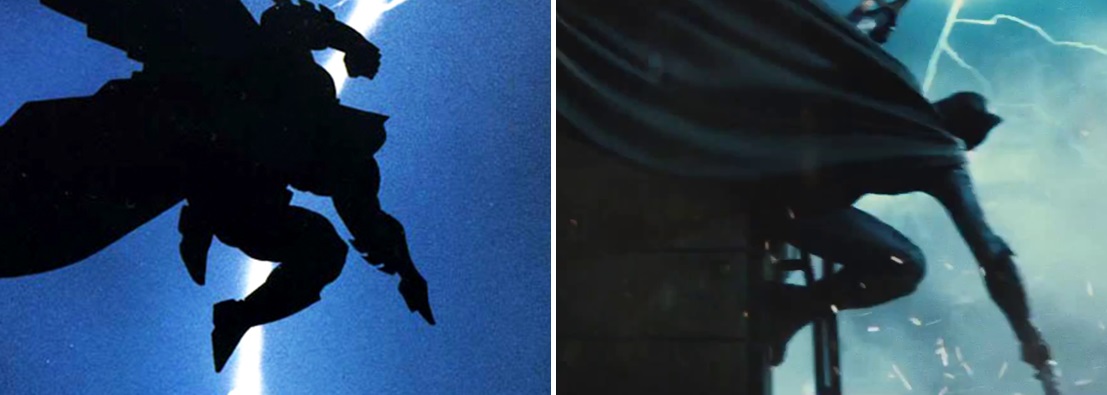
In the end, it's down to Superman to kill the beast. While the comics do not feature a Kryptonian spear, both The Death of Superman and the film have Superman throwing everything he has into one final attack, with Doomsday responding in kind. The resulting clash ends with them killing one another.
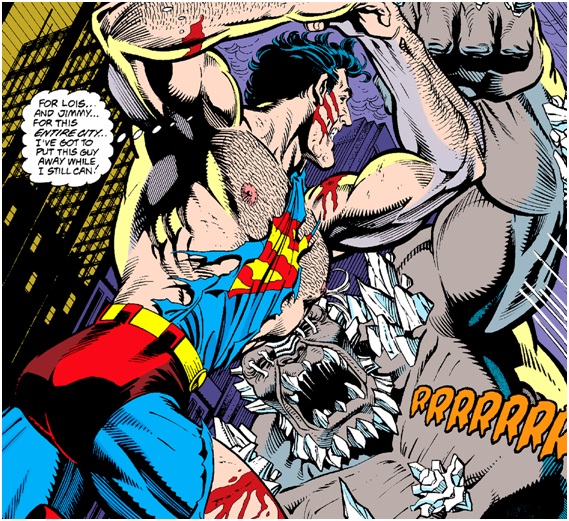
In the aftermath, a grief-stricken Lois cradles Superman's body. This evokes a memorable image from the comic. Though in the film Superman's costume is intact.
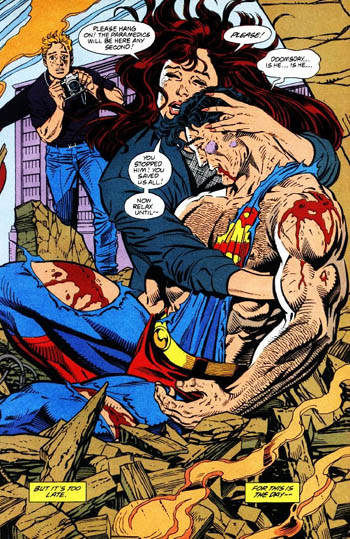
Following Superman's death, Lois receives a diamond engagement ring that Clark had intended to give her. She places the ring on her finger in acceptance of his unspoken proposal. Lois and Clark were also engaged when Superman was killed in the comics. In fact the Death of Superman storyline was partly conceived as a delaying tactic so their comic book wedding could be postponed to coincide with their live-action wedding in the TV series Lois & Clark: The New Adventures of Superman (1993-1997).
Elsewhere, Lex is imprisoned for his crimes and has his head shaved, bringing his appearance more in line with that of the traditional bald Luthor from the comics. During his final conversation with Batman, Luthor alludes to an extraterrestrial menace whose attention has now focused upon the Earth. This is likely a reference to Darkseid. The “ding, ding” noise Lex makes in this scene evokes the “ping, ping” sound made by Mother Boxes in the comics.
Superman’s coffin is adorned with a silver ‘S’ emblem. This evokes the silver shield he wore during The Return of Superman (1993) storyline.
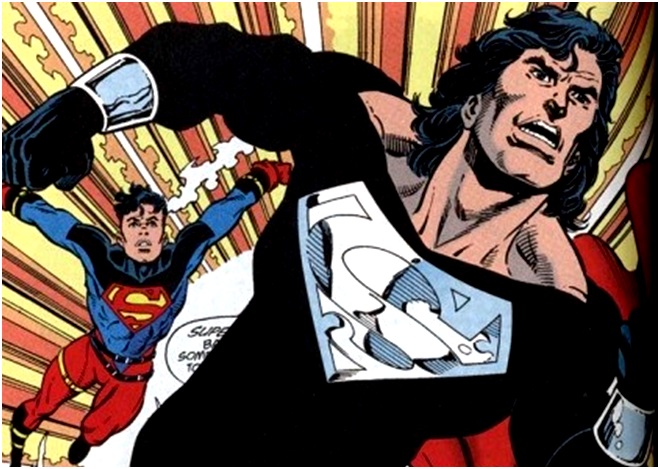
Bruce and Diana discuss uniting the other metahumans for a common cause, hinting at the formation of the Justice League. Meanwhile the soil above Clark’s coffin begins to move, implying Superman’s death may not be as permanent as it seems...
And that concludes this analysis of Batman v Superman: Dawn of Justice.
comments powered by Disqus












by Slash Man
by Silver Nemesis
by The Dark Knight
by Slash Man
by Slash Man
by The Joker
by Slash Man
by Gotham Knight
by Silver Nemesis
by The Joker